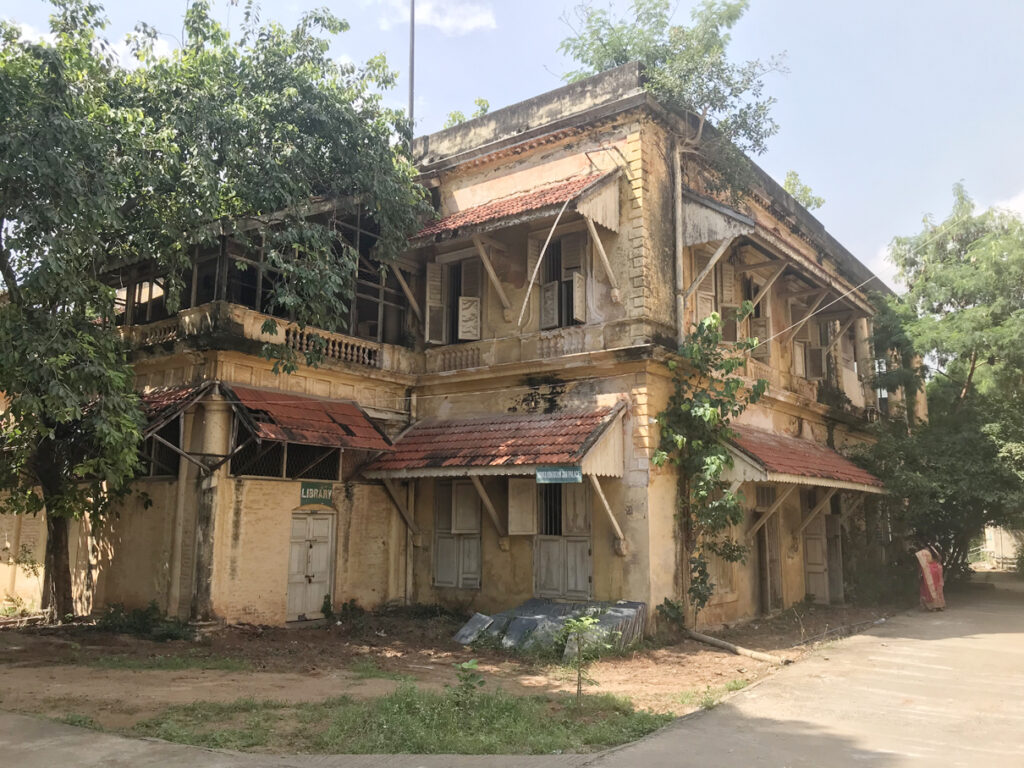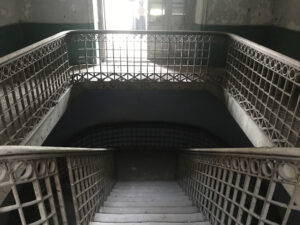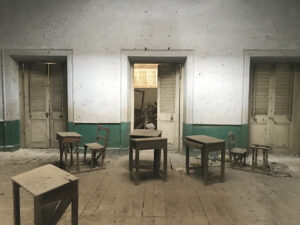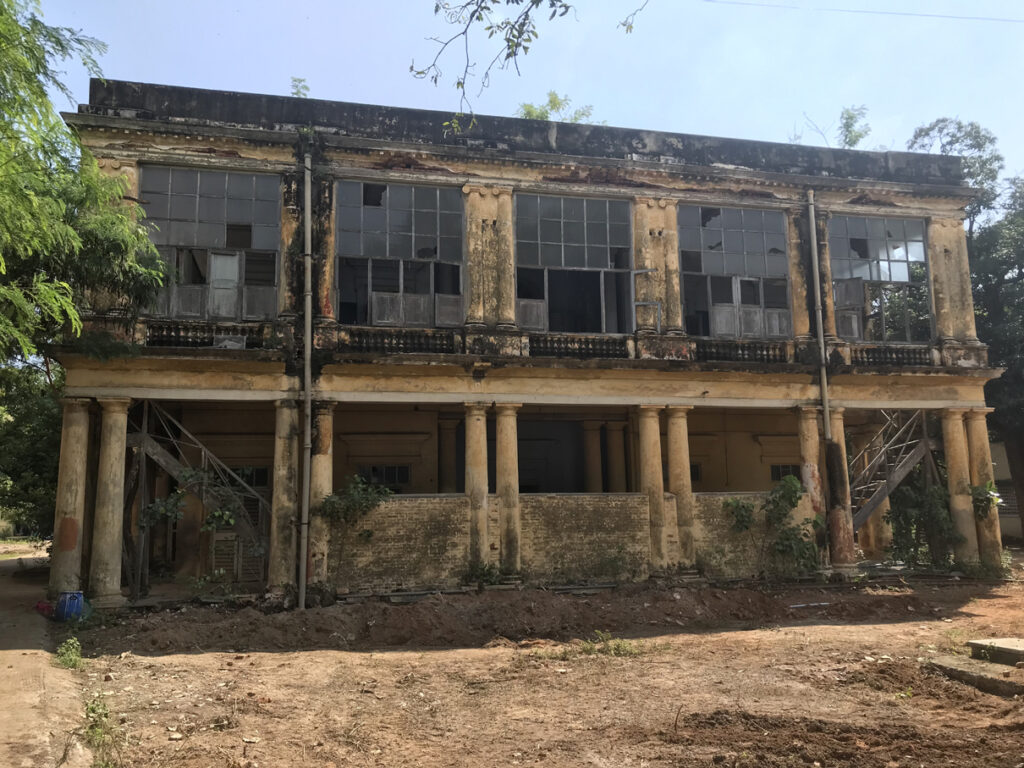Registered with the Registrar of Newspapers for India under R.N.I 53640/91
Vol. XXX No. 18, January 16-31, 2021
Lost Landmarks of Chennai
Where Nawabi families once resided

One of the last exploratory outings I had before the whole world went into lockdown owing to Covid was to the Government Hobart Higher Secondary School for Muslim Girls. That was in February 2019. That it has taken me more than a year to write this account is a reflection of my laziness and also perhaps of the times we live in. But looking back, it would seem like that visit was in another era. Children were playing in the vast grounds of the school. From somewhere came the sounds of a class (a real one) in progress. Students were chanting something together. Teachers were walking around busily. My friend Nikhath Suhail took me to meet the Principal and then, we walked around the premises till we came to the oldest building – known simply as the palace.
A two-storeyed structure, this was once the only building on the premises. The entire precinct was known in the early 19th Century as the Shah Sawar Jung Bagh though it is quite clear that the structure that I am gazing at is of late 19th Century vintage at best. In earlier times, this must have been an Arcot grandee’s garden, with perhaps a pavilion in the middle. Fortunately for us, we know who Shah Sawar Jung was.


The year was 1802. Around 12 months earlier, the last ruling Nawab of Arcot, Umdat-Ul-Umrah Bahadur had passed away. Taking advantage of the confusion that usually accompanied the succession to any Indian kingdom, the British, led by Governor Edward, the second Lord Clive had waded in. The crown was offered to Ali Hussein, the first son of the late Nawab, on terms that were not acceptable. This was probably premeditated, for the British immediately offered the throne to Azeem Ud Dowlah, a cousin, provided he agreed to hand over civil and military administration to them, in exchange for a pension that would maintain him and his immediate family. One of the chief challenges that the new Nawab would therefore face, was that of the disgruntled descendants of the erstwhile ruler. They had after all been used to the trappings of state by virtue of being princes. It is also quite likely that Azeem Ud Dowlah hoped that by alienating these people, he would be rid of the responsibility of maintaining them on the pension that the British paid him.
It is therefore no surprise that we find a letter dated December 30, 1802 from Azeem Ud Dowlah, to the Governor Lord Clive complaining that Shah Sawar Jung, “the reputed son by a Courtezan of the late Nawab Omdut ul Omrah” had behaved in an insolent manner towards him and this had necessitated his being confined to his apartments in Chepauk Palace, with sentinels posted at the door. The Nawab claims in his letter that he had however instructed that the prisoner ought to be given all that he desired by way of food but notwithstanding this, Shah Sawar Jung had thought it fit to complain to the Sudder Court of Madras that he was being denied basic necessities and therefore requested for safe passage out of the palace and permission to settle elsewhere in the city. The Nawab considered this an affront to his dignity and desired that the pension of Rs 15,000 per annum that was Shah Sawar Jung’s share be denied him. If he hoped that this amount would therefore accrue to him thereafter, the Nawab was sadly mistaken for the British immediately stopped the payments to Sawar Jung but did not think it fit to add the figure to the Nawab’s pension. Anyway, Shah Sawar Jung moved out of Chepauk and it is quite likely he settled down in this vast garden on White’s Road.

Not much is known of what happened to Shah Sawar Jung but sometime in the 1850s or so, the property passed into the hands of Mir Humayun Jah Bahadur. The ancestry of the new owner remains something of a mystery but he was certainly exceedingly wealthy. It is rather erroneously reported in most accounts that he was a descendant of Tipu Sultan. It was his wife who came from that lineage. Another account has it that Mir Humayun Jah was a descendant of Mir Asadullah Khan Bahadur, who was once preceptor to Safdar Ali Khan and sometime in the 18th century officiated as the Dewan of Tiruchirapalli during the absence of Chanda Sahib. Mir Humayun Jah, whatever be his source of wealth, was a man with multiple interests. He was one of the first Indians to be nominated to the Madras Legislative Council, interested himself in numerous charitable causes, endowed scholarships at various schools, colleges and the University of Madras and was frequently called upon to be a member of various committees of the Government of Madras. He was awarded the CIE for his services. He was, despite his loyalty to the British, also a member of the Congress party. His son Nawab Syed Mohammed was also a staunch Congress supporter.
In the 1870s, when Lord Hobart was the Governor of Madras, a primary school for Muslim girls was begun in the Royapettah area. This peregrinated till 1873 when Mir Humayun Jah Bahadur donated his property to the institution. It was named the Government Hobart School in memory of the Governor who had initiated the efforts for its founding and who in 1875 died in the city. The school has since prospered.
But not so the palace that stands in the middle. A visit to the place only highlights what poor maintenance, combined with lack of awareness of heritage can do to a historic structure. It is a two-storeyed building, fronted by what must have been a portico with a verandah on top. This has a railing of bellied balusters running around it. With time, both portico and verandah appear to have been walled in to make way for classrooms. But this was done very elegantly and care was taken to ensure that the new enclosures sported the same louvered windows topped with sloping tiled sunshades supported on wooden brackets that are present in the older parts of the building. It is clear that this renovation was done sometime in the 1920s or earlier.
What is interesting is that the entire building was cooled by means of terracotta flues – air ducts that opened on to the roof and therefore took away the heat. Walking into the dimly lit interior reveals a grand stairway, with wooden steps that are so shallow that they pose no strain to the feet. The bannisters on both sides look surprisingly modern though they are of wrought iron. The stairway divides on the first floor into a broad gallery that runs all around, with doors leading to the various chambers. The doors to the various rooms and the verandahs follow the same pattern as the windows – slats and louvres. The flooring on the first floor is entirely of wood, which creaks as you walk. It also sags in a few places. The rear wing of the palace sports a verandah on the ground floor, fronted by a series of twin Doric pillars. The corresponding space on the first floor is a long corridor, lit by a series of windows that are between the Doric pillars that rise from their counterparts below. The windows are of full height; they extend from floor to ceiling.
As a residence this must have been a delight. As a school, even more so. Imagine studying in such historic surroundings, with airy and naturally lit classrooms. But then the craze for modernity is inescapable and the school has now shifted to various humdrum structures on the campus. The palace is now a dump yard for old furniture. It is rarely opened. Plants grow from the crevices. Some of windows have fallen in. Lack of basic maintenance is what has caused the building to come to its present state. It is still structurally sound but do not be surprised if it is soon certified unfit for occupation and slated for demolition.

